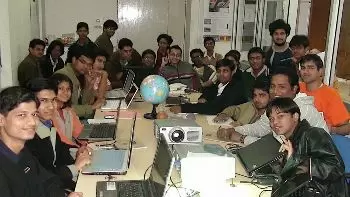IIT-Kanpur team burnt midnight oil to script Jugnu's success
01-November-2011
Vol 2 | Issue 43
The successful fabrication and launch of nano satellite Jugnu showcases how a band of enthusiastic IIT-Kanpur students burning the midnight oil pulled off the rare feat with their sheer hard work and sacrifices.
The team of 50 students worked around classes, assignments and exams, toiling at their lab, some well past 2 a.m. "You could probably find someone or the other sleeping in the lab itself and waking up early for a morning meet," said team leader Shashank Chintalagiri from Kanpur.
 |
|
Operation Jugnu: Students sacrificed sleep and social life to create the remote sensing nanosat that weighs just 3 kg. (Photo courtesy: IIT Kanpur)
|
Their complete involvement left them very little time for social life, but members struck up new friendships that grew into an extended family, making Jugnu and its sub-systems possible. Occasionally, celebrating someone's birthday or a new milestone did liven up their rather 'punishing' routine.
IITians inherited a different set of problems because the nanosat had to be built on a vastly smaller scale, virtually from scratch but with functions of their larger counterparts.
"We were initially torn between Indian Space Research Organisation's (ISRO) 'right way' of doing things and a more practical approach. Eventually, we decided to go ahead, taking cues from other nanosats built around the world," says Chintalagiri, a budding physicist.
"We would never have been able to achieve the size reduction we did by blindly following ISRO specifications. It helped that we were able to take greater risks, since we were operating at less than one percent of the cost of a regular satellite. All our individual experiences before the project gave us the foundation necessary to do this," adds Chintalagiri.
It wasn't smooth sailing all the way, though. There were plenty of hiccups, which they overcame by applying their skills and out-of the-box approach. Since a nanosat is a highly integrated system, even small changes in one place can cascade into a number of seemingly unrelated changes all over the satellite.
"For instance, we had to add a mere millimetre (mm) or so of spacing between two boards. That caused another board higher up in the stack to move by a couple of mm, causing other problems. But we overcame the glitch. It always was a very delicate balancing act, to be sure that the fix for one problem does not cause another.
The reason that we were able to solve a number of the problems, however, was preparation," recalls Chintalagiri.
A major difficulty involved people leaving the project midway before a replacement could be trained, recalls Chintalagiri. "Unfortunately, social and economic obligations did not generally allow people to stay on. Those who did were deeply involved in the project and knew that their being there for a year more would make a significant difference to the success of the satellite."
"Initially, there were only three members, doing a feasibility study of sorts. I believe the first group gathered sometime in March or April of 2008, and I joined the team in September. By then, there were already 10 to 15 people on board and we all knew what the satellite was going to look like," adds Chintalagiri.
As ISRO does not have ejection system for satellites below 10 kg, so designing one for Jugnu was a real challenge.
Ultimately, Amrit Sagar, who designed it, did the nation proud. It is a complex piece of technology that makes space missions possible by separating the satellite from the launch vehicle and placing it in a precise orbit. The mechanism went through dozens of rigorous tests before certification by the Vikram Sarabhai Space Centre, said IIT-Kanpur sources.
"The credit of the success of the mission goes to the student team . . . from various disciplines of engineering and science, who worked tirelessly to bring Jugnu to life," said Jugnu project leader N. Vyas, professor and head, mechanical engineering department, IIT-Kanpur. - IANS
















